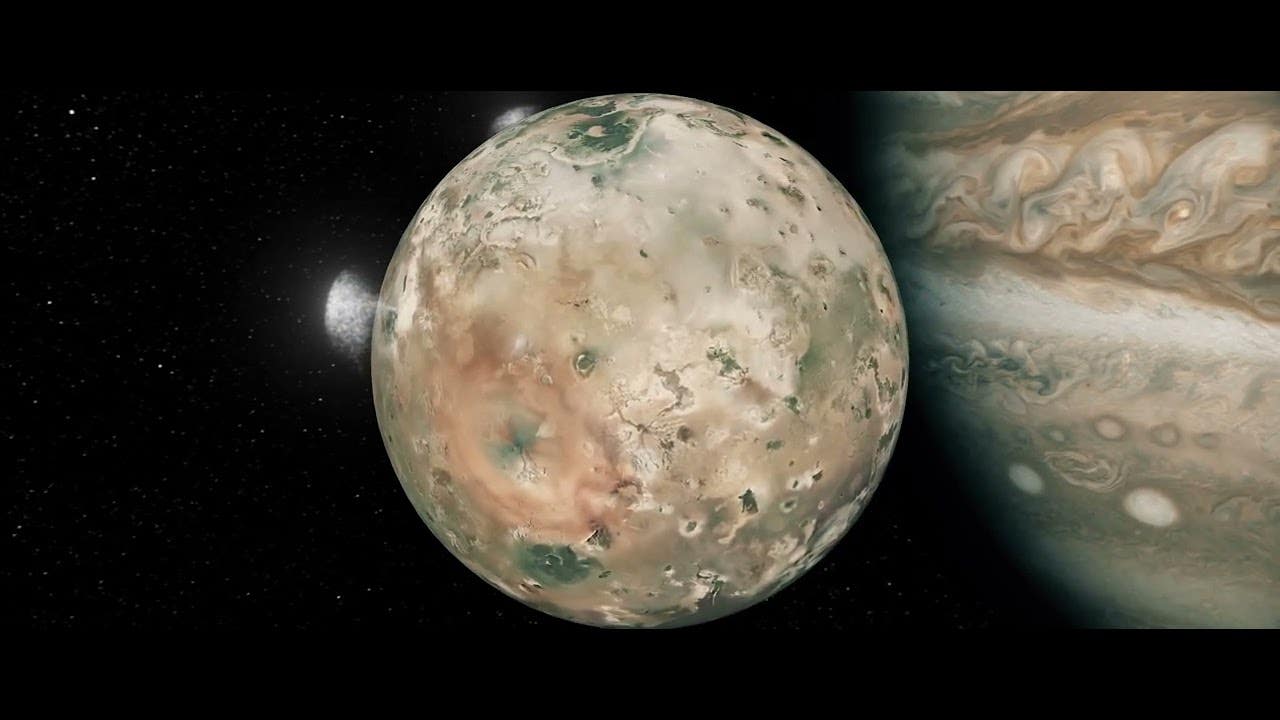NASA’s Juno mission solves Io’s 44-year-old volcano mystery
NASA’s Juno mission has revealed the source of Io’s intense volcanism, challenging previous theories of a global magma ocean.

Io’s fiery landscape and volcanic eruptions are a subject of fascination and scientific inquiry. (CREDIT: NASA/Caltech-JPL/SwRI)
As the innermost of Jupiter’s Galilean moons, Io offers a glimpse into some of the most extreme geologic phenomena in the solar system. Roughly the size of Earth’s Moon, Io’s surface is marked by intense volcanic activity, driven by unique internal dynamics.
This volcanic powerhouse orbits Jupiter every 42.5 hours along an elliptical path, where variations in the gas giant’s gravitational pull create immense tidal forces. These forces generate internal friction, heating Io to extraordinary levels and fueling its geologic activity.
Io’s volcanism sets it apart from every other celestial body in the solar system. It is home to an estimated 400 active volcanoes, continually spewing molten rock and gas. These eruptions create a surface coated in sulfur and volcanic deposits, earning it the nickname of a "pizza-faced" moon.
While Galileo Galilei first observed Io in 1610, its volcanic nature wasn’t discovered until nearly four centuries later. In 1979, NASA’s Voyager 1 spacecraft captured images of volcanic plumes, marking the first time such activity was observed beyond Earth.
Since then, planetary scientists have puzzled over the source of Io’s volcanism. Theories centered on whether its eruptions were fueled by a global subsurface magma ocean or smaller, localized magma chambers.
"Was there a shallow ocean of white-hot magma fueling the volcanoes, or was their source more localized?" asked Scott Bolton, principal investigator for NASA’s Juno mission at the Southwest Research Institute. Recent findings from Juno’s close flybys have finally begun to resolve this long-standing question.
In December 2023 and February 2024, Juno passed within 930 miles (1,500 kilometers) of Io’s surface, collecting high-precision data. By measuring subtle changes in the spacecraft’s velocity using NASA’s Deep Space Network, scientists were able to analyze Io’s gravitational field and its tidal response. These measurements provide critical insight into the moon’s internal structure and its dynamic interaction with Jupiter.
Io’s tidal response is a direct result of its proximity to Jupiter. The moon’s elliptical orbit causes varying gravitational forces to stretch and compress its interior, a phenomenon known as tidal flexing. This flexing generates immense internal heat, enough to melt portions of Io’s rocky interior. The process is so extreme that Io dissipates approximately 100 terawatts of energy—a power output far greater than all of Earth’s geologic activity combined.
Related Stories
The key to understanding Io’s volcanism lies in whether this tidal heating creates a global magma ocean or localized magma reservoirs. If Io harbored a global magma ocean, its tidal deformation would exhibit a significantly larger signature compared to a more rigid, mostly solid interior.
However, Juno’s measurements revealed a tidal response inconsistent with the presence of such an ocean. Instead, the data suggest that each volcano is powered by its own localized chamber of molten rock.
“Juno’s discovery that tidal forces do not always create global magma oceans does more than prompt us to rethink what we know about Io’s interior,” explained Ryan Park, lead author of a recent paper on the findings and supervisor of the Solar System Dynamics Group at NASA’s Jet Propulsion Laboratory.
“It has implications for our understanding of other moons, such as Enceladus and Europa, and even exoplanets and super-Earths. Our new findings provide an opportunity to rethink what we know about planetary formation and evolution,” he continued.
The possibility of a global magma ocean had been proposed based on earlier magnetic induction measurements from NASA’s Galileo mission. These measurements suggested the presence of a near-surface layer about 50 kilometers thick with more than 20% melt. However, these results have been debated for decades, with some researchers questioning whether such a layer could exist. Juno’s detailed gravity measurements now provide a clearer picture.
During its close encounters, Juno detected tidal deformations that align with a model of Io having a partially molten but mostly solid interior.
These findings are supported by observations of volcanic heat flow distribution across Io’s surface. The localized nature of the heat flow further suggests that magma is concentrated in isolated chambers beneath individual volcanoes rather than spread across a global ocean.
“This constant flexing creates immense energy, which literally melts portions of Io’s interior,” Bolton noted. “If Io had a global magma ocean, we knew the signature of its tidal deformation would be much larger than what we observed.”
The results from Juno’s flybys offer profound insights into the mechanics of tidal heating and its implications for planetary evolution. By showing that tidal forces on Io produce localized magma reservoirs, the findings challenge assumptions about similar processes on other celestial bodies.
For example, Saturn’s moon Enceladus and Jupiter’s moon Europa also experience tidal heating, and both are thought to have subsurface oceans of liquid water. Understanding the variability in tidal heating outcomes can help refine models of these moons and even distant exoplanets.
Io’s volcanism is an extreme example of how tidal forces can shape a celestial body. The moon’s metallic core, inferred from gravitational measurements, plays a role in its geologic activity.
As tidal forces flex Io’s interior, molten rock migrates through pathways influenced by the moon’s crustal density and volatile content. These properties determine whether magma accumulates in localized chambers or erupts onto the surface.
The discovery of Io’s localized magma reservoirs also builds on decades of research into the moon’s internal structure. Earlier studies attempted to quantify Io’s tidal response using a parameter known as the tidal Love number, which measures how the moon deforms under Jupiter’s gravitational pull.
While previous measurements provided some insights, they were unable to independently determine key components of the response. Juno’s precision data has now filled in these gaps, providing a more comprehensive understanding of Io’s interior.
While Io remains a unique case, the principles revealed by Juno’s mission have far-reaching implications. By studying how tidal heating generates magma reservoirs rather than oceans, scientists gain a deeper understanding of planetary formation and geologic processes. These insights could inform future missions to other moons and exoplanets, where tidal forces may similarly influence internal dynamics.
Juno’s mission to Io is far from over. The spacecraft recently completed its 66th science flyby of Jupiter and will continue to explore the Jovian system. Its next close approach to the gas giant is scheduled for December 27, 2024, when it will pass just 2,175 miles (3,500 kilometers) above Jupiter’s cloud tops.
Since entering orbit around Jupiter in 2016, Juno has traveled over 645 million miles, providing a wealth of data about the planet and its moons.
Io’s fiery landscape and volcanic eruptions remain a subject of fascination and scientific inquiry. The findings from Juno’s flybys mark a significant milestone in understanding the moon’s unique geology. By uncovering the localized nature of Io’s magma sources, scientists are rewriting the narrative of how tidal forces shape celestial bodies.
The discoveries on Io may serve as a template for exploring the internal dynamics of other worlds, both within our solar system and beyond.
Note: Materials provided above by The Brighter Side of News. Content may be edited for style and length.
Like these kind of feel good stories? Get The Brighter Side of News' newsletter.
Joshua Shavit
Science & Technology Writer | AI and Robotics Reporter
Joshua Shavit is a Los Angeles-based science and technology writer with a passion for exploring the breakthroughs shaping the future. As a contributor to The Brighter Side of News, he focuses on positive and transformative advancements in AI, technology, physics, engineering, robotics and space science. Joshua is currently working towards a Bachelor of Science in Business Administration at the University of California, Berkeley. He combines his academic background with a talent for storytelling, making complex scientific discoveries engaging and accessible. His work highlights the innovators behind the ideas, bringing readers closer to the people driving progress.



